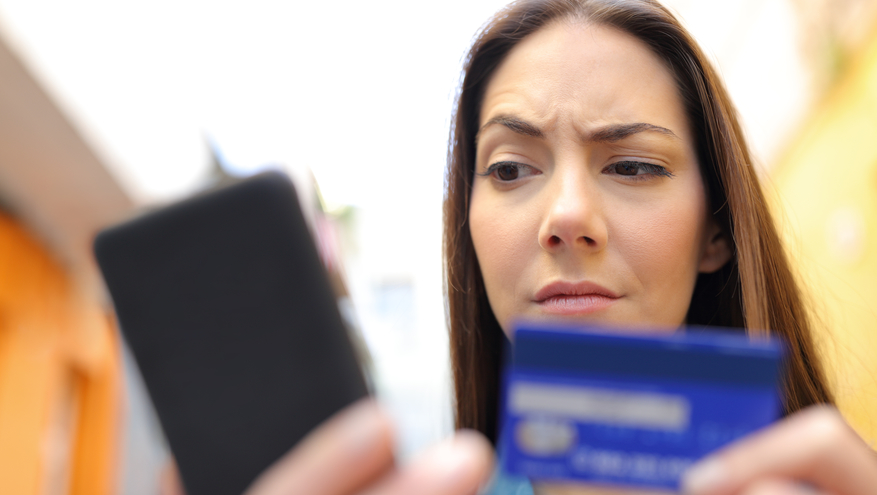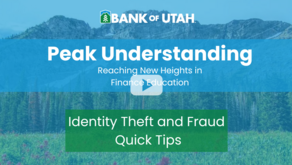Fraud. It is only one, small, five-letter word; however, it is arguably one of the most destructive five-letter words in our society today. Fraud comes in many forms, including check fraud, debit card fraud, email fraud, wire fraud, identity fraud, and so on. Fraud does not discriminate, impacting a broad, diverse range of individuals and businesses. There is business fraud which our bank takes great measures to control and combat, and personal fraud that a bank can’t control. Our goal here at Bank of Utah is to help everyone become more aware of what fraud is, what it looks like and how to protect yourself from becoming the next fraud victim. I will briefly describe some of the most common types of fraud we see and how to make sure YOU are not a victim of this devastating crime.
Check Fraud
This type of fraud could be considered a fraudster’s “favorite.” It is relatively easy for it to happen and unless you monitor your accounts frequently, it could go undetected for quite some time. Take a look at your checks; what information do you see on there? Is this information personal, is it valuable to you? I am sure you are answering, “Yes! Of course it is.” Paper checks have A LOT of your private, personal information on them: your name, address, sometimes your telephone number, and most importantly your ACCOUNT NUMBER. Look at the bottom of your check, those series of numbers are in fact, the routing and account numbers to your very personal checking account. I can imagine you would never think of handing out your account number written on a note to the postal worker, to the employee at a store, or to the waiter at a restaurant, but when you write checks, you are doing just that. The more hands that your paper check pass through, the higher the risk that you may be the next check fraud victim.
You may be asking, what can they do with that information? Fraudsters can create their own checks using your account number, alter who it is written to or the amount, etc. Paper checks are a high risk for fraud because they don’t have extra safeguards in place. Basically, if the money is in your account when a check is presented, it will clear your account.
However, do not panic! There are many ways Bank of Utah can help you protect your accounts while you still write paper checks. We have the convenience of online banking and a mobile banking app that allows you to monitor your accounts 24/7. Make it part of your routine to login and verify the checks drawing from your account.
You can also sign up for account alerts on our online banking platform. You will be able to set parameter amounts for your accounts and if the account falls below your set amount, you will receive an alert on your cell phone.
Within online banking, we also have an online bill pay system that allows you to set up payees and send them your payment, free of charge.
If you’re a business owner or operator who writes checks, we also offer fraud protection through Positive Pay. This part of our online banking platform gives businesses an extra layer of security with check writing. Simply log into online banking and see the checks that are hitting your account each morning to confirm that they are legitimate.
Debit Card Fraud
This type of fraud is growing as more of us love the convenience of using a card for our purchases and payments. Ror the most part, debit card fraud is quicker to catch than check fraud because there are more digital safeguards in place. However, don’t think that fraudsters cannot be successful stealing money this way…they absolutely can.
Debit card fraud happens a couple of ways. It can happen at physical locations where the fraudsters have placed what is called a “skimming device” on the card reader machines in stores. One of the most common is at gas stations where you do not go inside to purchase your gas. A quick way to protect yourself here is to try to pull on the card reader machine, does anything come off? Look closely at the machine, does it look normal? If the answer is no to either of these questions, do not use it and inform a store manager.
When shopping online, make sure you go to the actual website of the vendor you are wanting to purchase product from. If you receive a discount code via Facebook, Instagram, email or text, copy the code down and make the purchase on the actual company’s website. To avoid social media scams, don’t click on shopping links in social ads, emails or texts. Fraudsters disguise themselves as being a legitimate business or a person to trick you.
Using online banking and/or mobile banking app is another way that you can protect yourself from debit card fraud. Monitor your accounts at your convenience on a regular basis. Keep an eye out for any unfamiliar charges, and notify the bank if you see anything questionable.
If you really want to take it to the next level of protection, but still keep the convenience and ease of using a card, the safest plastic out there is a credit card. Seriously, don’t cringe, think about it! A debit card is attached to your personal account, a credit card is not. Just make sure the charge you put on your credit card does not exceed the balance in your debit account, and pay it off right away.
Email Fraud
Lastly, email fraud. This form is becoming a common way for fraudsters to attempt to steal either your personal account information, identity or both. Both businesses and individuals alike can be victims of email scams. Email fraud looks like you are receiving an email from a business, organization or individual requesting payment through electronic wires. The email will contain what appears to be legitimate bank information for your wire payment, and sadly when you make the payment, you’ll discover the email was a fake. How do fraudsters do it? They hack your email account, look through your emails to see past payment requests and create a fake one.
How can you tell if an email is fake?
First, hover your mouse over the sender’s email and look to see if the email address matches the actual sender. Does the email address make sense for who it is from?
Second, hover your mouse over the link in the email and read the box that pops up over it. Does it appear go where you’d expect? Does it match who you believe the email is from? Do not click on the link.
Finally, if everything checks out from your inspection, reach out to the individual or business and confirm the wire instructions on a legitimate phone number.
I understand that all types of fraud seem scary and intimidating. However if you reach out to your trusted advisors at your financial institution and ask them for help and understanding, they will be more than happy to assist and help protect you. We are all in this together!
Melissa Bernson is VP Regional Retail Banking Manager for Bank of Utah. She has over a decade of banking experience, including previously leading our Ogden-Corporate branch as branch manager.




